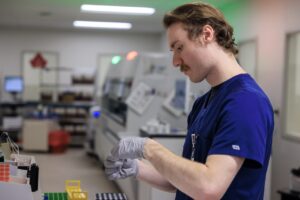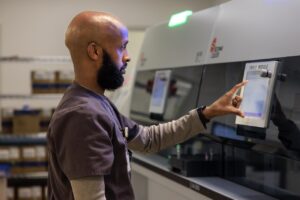
 Winding its way through Trinity Health’s main Laboratory is a conveyor system that gives lab samples the ride of their lives. Under the guiding hand of a medical laboratory scientist, the samples nestle into a test tube rack aboard the conveyor. The journey begins with an exciting spin in the centrifuge; then it’s on to a series of sightseeing stops to experience chemistry analyzers, hematology analyzers, immunoassay analyzers and more.
Winding its way through Trinity Health’s main Laboratory is a conveyor system that gives lab samples the ride of their lives. Under the guiding hand of a medical laboratory scientist, the samples nestle into a test tube rack aboard the conveyor. The journey begins with an exciting spin in the centrifuge; then it’s on to a series of sightseeing stops to experience chemistry analyzers, hematology analyzers, immunoassay analyzers and more.
Trinity Health’s new Healthcare Campus and Medical District was designed to accommodate new technologies, and the Laboratory’s state-of-the-art automation line is a prime example. The DxA 5000 Laboratory Automation System by Beckman Coulder Diagnostics was created to streamline and automate the processing and testing of lab samples to ensure that patients and doctors get health results as quickly and accurately as possible.
“Automation lines were designed to take on the key pre- and post-analytical steps in processing lab samples,” said Laboratory Director Pala Waswick, MLS, a 42-year veteran of the Lab. “It’s not the solution to all the world’s problems, but it’s a useful tool.”
Processes such as decapping, centrifuging (separating blood components), placing samples in an analyzer, recapping, storage and retrieval – these are steps that used to be performed manually. “Now, with the automation line we can take any kind of sample that’s appropriate for the line, such as blood, urine or body fluid, and put them all in one rack. Then we can go to a single-entry point on the automation line, and from there the system knows everything that needs to be done to each sample.”
Such a high level of automation is striking, almost magical. For example, the system knows to prioritize a “stat” test, a test that must be performed immediately. If a lab sample needs multiple tests, the system can sense whether there’s enough fluid in the sample to complete each test; if not, the machine will alert the technologist. Such built-in sensitivity is attributable to advanced computer software (actually, middleware) called REMISOL. “It’s the brains of our automation line,” Waswick said. “It drives the line.”
REMISOL Middleware is designed to work in harmony with Oracle Cerner, the provider of Trinity Health’s electronic health record. “Physicians place orders in Cerner, and REMISOL and Cerner talk to each other,” Waswick explains. “Once the tubes (lab samples) get put on the automation line, REMISOL is telling the system – you have to do this testing and this needs to go to that analyzer and so on. It’s very intelligent.”
Trinity’s Lab has an entire complement of automated line components. Along with two chemistry and two hematology analyzers – the big shoulders of the Lab, it also has two immunoassay analyzers that are used to identify and detect the concentration of specific substances in a sample. Other tools and outlets are also available on the line, along with safe disposal and/or storage.
Such a highly sophisticated system takes time to fine-tune. Trinity Health has been working with the line’s vendor to make tweaks in the software, a process that will go on for some time. Yet, already Waswick has identified ways that the automated line has been beneficial to patient care.
“Number one is consistency in turnaround time,” she says. “Back when we used to process tests more manually, it might be that the test would go quickly or other times it might not be as quick if there was something else going in the Lab that needed attention. On the line, everything becomes consistent.”
A second improvement is the system’s sample quality detection feature with nine parameters. “It can look at a bar code to see if it’s the right tube and if there’s enough volume in the sample. It definitely enhances sample integrity,” she states.
Thirdly, the automation line prioritizes samples, something Lab staff used to do manually. And add a fourth benefit to the list – with scientists and lab assistants doing less handling of the samples, there’s less risk of biohazard exposure.
Even with the automated line, Trinity’s lab scientists still have plenty to do. The Lab is accredited by the College of American Pathologists (CAP), which surveys the Lab every two years. “There are CAP regulatory responsibilities that we perform on a daily basis,” Waswick said. “We spend hours doing calibrations, quality control, instrument validation. We are quality assurance-heavy.”
According to Waswick, Trinity Health’s Laboratory is unique among hospital labs in the state in its broad testing menu. “I’ve always been very proud of Trinity,” she states. “We’ve always recognized that because of where we sit geographically, we make it a point to perform more in-house testing instead of sending tests out. Our physicians like it because it supports more timely patient care decisions.”
Now there is another reason to be proud. Just recently the Lab began measuring turnaround for the Emergency Department as a result of the automated line. “We’re starting to see some consistency that appears to be having an impact on getting patients in and out faster. That’s exciting,” Waswick said.



